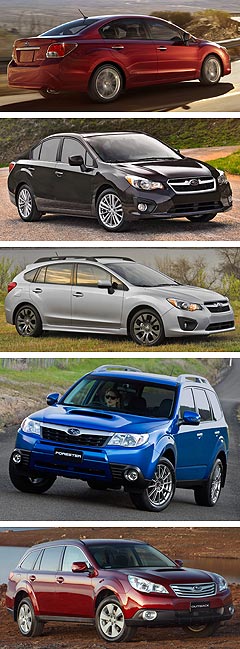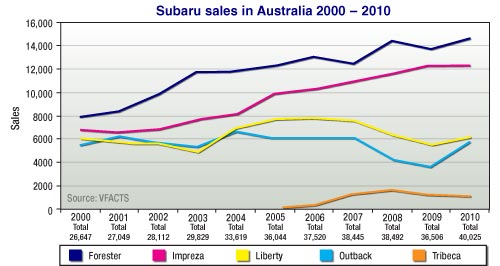Make / Model Search
News - Market Insight - Market Insight 2011Market Insight: Lessons from SubaruRex appeal: Subaru is averaging more than 200 WRX sales a month this year, which is ‘well ahead’ of the company’s expectations. Subaru continues to rack up annual sales records on back of premium positioning30 May 2011 By TERRY MARTIN NINE years ago, almost to the day, Subaru Australia’s former managing director Trevor Amery sat in the company’s massive new $40 million Docklands dealership in Melbourne, talking in detail to this writer about the Japanese brand’s position in this country. In 2002, Subaru was working towards 28,000 sales for the year – the fifth all-time consecutive record for the brand – but Mr Amery was reluctant to commit to a target set by parent Fuji Heavy Industries of 30,000 units by 2005. With no new model lines on the horizon, he saw 28,000 as the “upper end of our volume” and said in no uncertain terms that the overriding focus for the brand, distributed by Inchcape Motors Australia, was on “quality sales” and an upmarket positioning of its model quartet: Forester, Impreza, Liberty and Outback (Tribeca came later in 2006). “We’re working at having quality sales in the segments we compete in,” Mr Amery said at the time. “If that means there’s a new product coming into another segment, that (30,000) might be feasible, but I think one of the things that in the discussions we’ve had with Fuji is not about pure volume, it’s about a quality, premium position for the brand. “At what point does the premium positioning finish and a mass-market positioning start?” And there was this statement, made more than once: “We never go about making outlandish claims about what we might do. We just get on with it. We’re just a quirky, little car company.” History shows that the “quirky, little” brand easily made 30,000 sales in 2005 – the year that Subaru stalwart (circa 1991) Nick Senior took over as MD as Amery became chairman – with more than 36,000 new registrations, and it has continued its steady climb virtually every year since.  From top: Next-generation Subaru Impreza, Subaru Forester S-Edition, Subaru Outback diesel. From top: Next-generation Subaru Impreza, Subaru Forester S-Edition, Subaru Outback diesel.The one exception was 2009, as the effects of the economic downturn were still being felt, but the brand rebounded last year to break through 40,000 units for the first time. It was the 12th all-time sales record for Subaru over the past 13 years. There are no light cars or commercial vehicles driving sales volume, and while Tribeca has contributed around 1200 sales a year, this looks, to some extent, to have come at the expense of Outback, which took a dive in 2008/09 and only last year clawed back past 5000 units – the sort of annual figure Subaru has come to expect from the model for more than a decade. Diesel engine variants for Outback and Forester have bolstered sales, but what is striking here is that Subaru has indeed “just got on with it” – with a minimum of fuss, a limited model range and strict adherence to the potentially volume-curbing all-wheel-drive/boxer engine ethos. Existing and prospective buyers have clearly appreciated this position, and other appealing factors such as strong resale values and, at an international level, a willingness to respond to criticism such as styling. Perhaps above all, Subaru has simply continued to roll out desirable vehicles in both performance and off-road spheres. For this reason, Subaru management seems confident the brand can withstand a change in policy with the introduction of a sportscar – expected in 2012 – developed jointly with Toyota that will have a boxer engine but drop AWD in favour of rear-wheel drive. Time will tell on that one. There are also other moves afoot to make the Subaru range more diverse. After dropping the ‘Impreza’ moniker on its WRX/STI performance twins to separate them out from the mainstream range, Subaru will take this naming strategy further with the forthcoming new-generation Impreza, due late this year or, depending on post-earthquake production schedules, early in 2012. While the redesigned model should boost sales as a matter of course, Subaru will split the range even further with a revamped off-road-oriented XV, which will also lose the Impreza label. It remains to be seen, however, whether the production XV takes on a bona fide SUV body style or even a more rugged persona than the current effort – and whether this has any effect on sales. Other growth areas are less well defined, although Subaru Australia – which has considerable clout in Japan – is known to be pushing the case for automatic transmission options for its diesel range and has also discussed broadening the diesel line-up with an oil-burner for Liberty. In line with the softening new-vehicle market, Subaru sales to the end of April were down 1.8 per cent, with Impreza holding the fort – up 37.7 per cent – and compensating for some significant declines: Liberty (down 38.7 per cent), Tribeca (-13.2), Forester (-8.0) and Outback (-8.4). That said, Forester – which does without a two-wheel drive variant but has benefited this year from the introduction of the high-performance S-Edition – was still the biggest-selling compact SUV in Australia to the end of April, with 4330 sales and an 11.4 per cent share of the segment. It has also been the top-selling compact SUV for the past three years. Subaru also confirmed to GoAuto last week that WRX sales were well ahead of expectation – averaging 217 a month – and that S-Edition was accounting for around six per cent of Forester sales volume. Diesel is this year making up 13 per cent of Forester sales and 16 per cent of Outback sales, which is ahead of the 10 per cent forecast for both models. After a record first quarter, with sales up 5.0 per cent in a market down 1.3 per cent, Subaru says supply problems stemming from the March 11 earthquake in Japan impacted its sales in April – the brand was down 23.6 per cent for the month – and that the situation in Japan is still so fluid that all bets are off for another record result for the year. Subaru’s share of the overall new-vehicle market to the end of April was 4.1 per cent for a solid eighth place, having shrugged off its typically tight-run sales race with Honda (down to 3.1 per cent share YTD on the back of a 25.8 per cent sales fall to April 30) but finding heat from Volkswagen, up to 3.7 per cent YTD. There is daylight to the bigger brands covering all the big-volume market segments, including commercial vehicles – Mitsubishi is next on 6.4 per cent, then Nissan (7.0), Hyundai (8.4) and the other big players in Ford (9.0), Mazda (9.1), Holden (12.0) and Toyota (19.1) – but Subaru sees no need to go chasing volume. While Volkswagen looks certain to overtake Subaru at some point, the Australian distributor of the “quirky little car company” is still intent on modest and profitable growth with a few core models that carry a strong, simple message about premium quality in the minds of mainstream car buyers. And that is clearly no bad thing.  Read more2nd of May 2011  Three pointed stars from SubaruSubaru’s radical small-car strategy unfolds as Impreza splits into three26th of April 2011  Baby Subaru might returnTrue Subaru light-car is not dead forever, despite re-badging Toyotas and Daihatsus |
Click to shareMarket Insight articlesResearch Market Insight Motor industry news |











Facebook Twitter Instagram